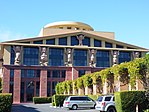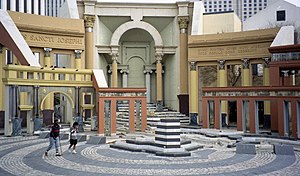Postmodern architecture
Top left:Vanna Venturi House by Robert Venturi; Top right:Team Disney building in Burbank, California by Michael Graves; Center left: Guild House in Philadelphia by Robert Venturi; Center: 550 Madison Avenue by Philip Johnson: Center right:PPG Place in Pittsburgh by Philip Johnson: Bottom: Piazza d'Italia, New Orleans by Charles Moore
|
||||||||
| Years active | 1960s-2000 | |||||||
|---|---|---|---|---|---|---|---|---|
| Country | international | |||||||
Postmodern architecture is a style or movement which emerged in the 1960s as a reaction against the austerity, formality, and lack of variety of modern architecture, particularly in the international style advocated by Le Corbusier and Ludwig Mies van der Rohe. The movement was given a doctrine by the architect and architectural theorist Robert Venturi in his 1966 book Complexity and Contradiction in Architecture. The style flourished from the 1980s through the 1990s, particularly in the work of Venturi, Philip Johnson, Charles Moore and Michael Graves. In the late 1990s it divided into a multitude of new tendencies, including high-tech architecture, neo-classicism and deconstructivism.
Postmodern architecture emerged in the 1960s as a reaction against the perceived shortcomings of modern architecture, particularly its rigid doctrines, its uniformity, its lack of ornament, and its habit of ignoring the history and culture of the cities where it appeared. The architect and architectural historian Robert Venturi led the attack in 1966 In his book, "Complexity and Contradiction in Architecture" Venturi summarized the kind of architecture he wanted to see replace modernism:
"I speak of a complex and contradictory architecture based on the richness and ambiguity of modern experience, including that experience which is inherent in art … I welcome the problems and exploit the uncertainties … I like elements which are hybrid rather than "pure", compromising rather than "clean", … accommodating rather than excluding … I am for messy vitality over obvious unity … I prefer "both-and" to "either-or", black and white, and sometimes gray, to black or white … An architecture of complexity and contradiction must embody the difficult unity of inclusion rather than the easy unity of exclusion."
In place of the functional doctrines of modernism, Venturi proposed giving primary emphasis to the facade, incorporating historical elements, a subtle use of unusual materials and historical allusions, and the use of fragmentation and modulations to make the building interesting. Venturi's second book, Learning from Las Vegas (1972), co-authored with his wife, Denise Scott Brown, and Steven Izenour, further developed his argument against modernism. He urged architects take into consideration and to celebrate the existing architecture in a place, rather than to try to impose a visionary utopia from their own fantasies. He argued that ornamental and decorative elements "accommodate existing needs for variety and communication".was instrumental in opening readers eyes to new ways of thinking about buildings, as it drew from the entire history of architecture—both high-style and vernacular, both historic and modern—and In response to To Mies van der Rohe's famous maxim "Less is more" , Venturi responded, to "Less is a bore." Venturi cited the examples of his own buildings, Guild House, in Philadelphia, as examples of a new style that welcomed variety and historical references, without returning to academic revival of old styles.
...
Wikipedia






